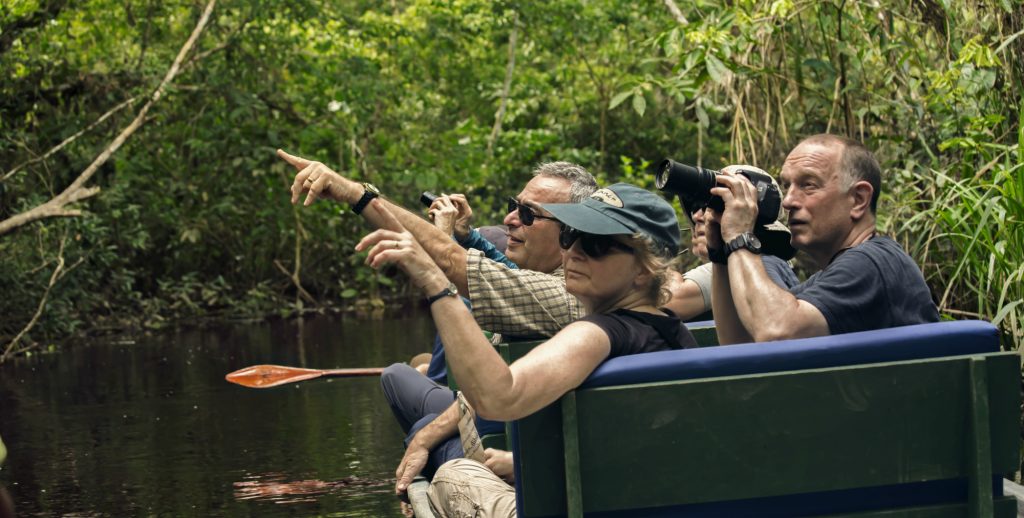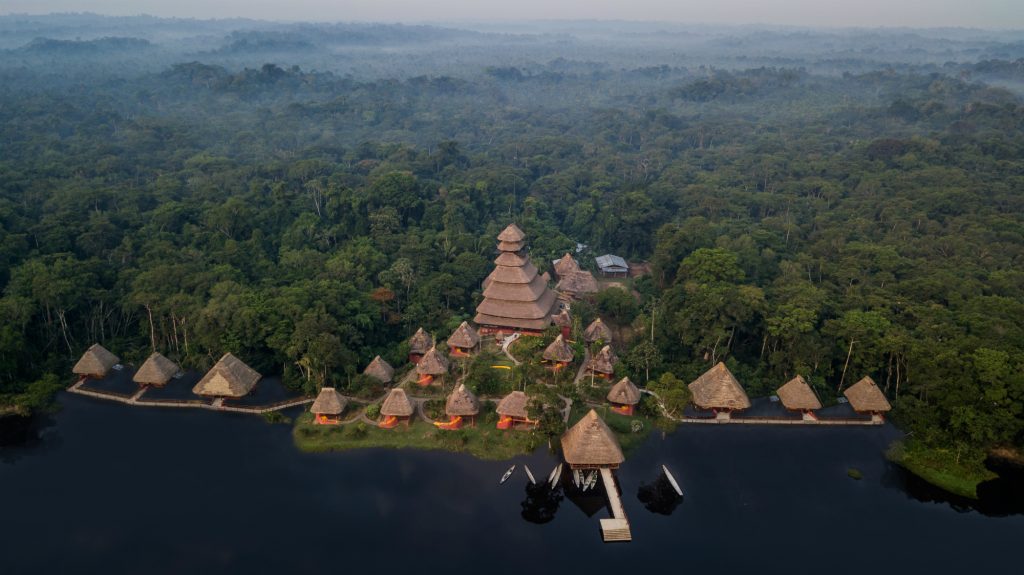Two years ago, I traveled to the Ecuadorian Amazon to visit the Napo Wildlife Center, an Indigenous-operated ecolodge in Yasuni National Park. It was an amazing experience — a place none of my colleagues in the meetings and incentive industry had heard of prior to my visit, and one they probably became sick of hearing about once I returned.
The whole time I was there, I kept thinking the Napo Wildlife Center was perfect for small incentive groups. It checked all the boxes: It was a unique and unforgettable experience. The accommodations were at least four stars. It was also easy to get to; it’s only a five-hour flight from Houston, Texas, to Quito and then 50 minutes from there to Coca, where the Napo adventure begins. The daily excursions were outdoorsy but not very physically challenging, and it was educational from both a cultural and environmental perspective. There was space in the lodge for group gatherings and the food was great too!

As someone who has spent significant time working in both the meetings and incentives space as well as in adventure travel, experiences like the one at Napo have led me to believe new opportunities exist for these types of destinations. I believe destinations and tour operators that have traditionally operated in the high-end adventure travel space can pursue — and win — incentive business. While this is true for destinations all over the world, an examination of the newly released Incentive Travel Industry Index indicates it’s an auspicious time for operators and emerging destinations in Latin America in particular.
Why Incentive Travel?
Incentive travel is new to many organizations that have traditionally focused on adventure travel, so let’s start with the basics.
Companies use these types of programs to affect overall business outcomes or to encourage certain behaviors from employees, sales people, channel partners (e.g., dealers and distributors), and/or customers. The Index, a study of the global incentive travel industry, outlines the top three benefits companies hope to receive by running incentive trips:
- Increased sales and/or profits for the company.
- Improved engagement (employees or channel partners).
- Increase individual productivity.
- Better relationship building between employees and management.
- Improved retention (employees or channel partners).
- Better relationship building among employees.
In addition to understanding why companies run incentives, it is important to understand how they select destinations. According to the survey, the following are the most important considerations in selecting a destination for an incentive travel program:
- Infrastructure (such as quality hotels for handling incentive programs).
- Overall participant safety.
- Appeal of the destination to the participant audience.
- Value for money.
- Good destination management companies present in the destination.
- Access from trip winners’ cities.
Central American destinations ranked sixth on the list with 50% of the respondents indicating they have planned or will operate programs there in 2019. Of the 50%, only 17% indicated they use the region frequently. South America came in at 39%. Eleven percent of companies reported frequent use of the location as a destination, though 18% of respondents plan on using South American destinations more in 2020 and 2021, with 15% indicating the same for Central America.
It seems clear the reason more “far-flung” destinations are not seeing as much business can be directly correlated to average trip duration. No matter the travel time, the vast majority of incentive trips last three to five nights. Longer trips are more cost-prohibitive and keep top producers out of the office, which affects both budgets and the bottom line. Because of this, long-haul destinations or those that are simply hard to reach are at a major disadvantage when trying to attract this type of business.
What Incentive Winners Want
Anyone working in the travel industry has likely heard about the changing definition of luxury. Dorine Reinstein from Travel Weekly put it best: "The concept of luxury travel has fundamentally changed and evolved over the years … the glamour associated with opulent accommodations and crystal chandeliers has once and for all made way for a very different kind of upscale travel: the luxury of adventure, experience, authenticity, and uninterrupted time."
As has been the case in the leisure market, this evolution is an opportunity for destinations and operators that can deliver on this new definition of luxury for the incentive market. However, the incentive industry is always slower to adopt new trends, and the breadth of trip attendees is the reason why. According to Rhonda Brewer, vice president of North American sales for BCD Travel, “What makes it tough is that you might have five generations on an incentive trip, and you have to find a way to appeal to them all. Some might want golf and fine dining, and others might want more adventurous experiences and community giveback programs.”

Brewer said there is an opportunity for adventure-oriented destinations and operators because adventure travel provides a bonding experience, which is an important reason why companies are running incentive programs. “You are conquering things together,” she said. However, she warned this type of travel needs to be challenging but not dangerous.
Challenges and Misconceptions
Safety, Security, and Insurance
Over the last several years, I have spent quite a bit of time talking to incentive planners about travel opportunities like Napo. Immediate questions concern safety, security, and insurance. Yes, suppliers must carry certain levels of insurance to satisfy these corporate clients, though there seems to be a stereotype at work when it comes to traveler safety in Central and South America.
Put bluntly, “if any trip winner feels unsafe with a destination, a company won’t go,” Brewer said. Yes, there aret dangerous cities in Latin America (just as there are everywhere in the world), however adventure-based trips don’t operate in major cities. Unfortunately, these preconceived notions exist, and destinations and operators need to address and overcome them.
Brewer mentioned that, several years ago, when Mexican drug violence dominated U.S. headlines, tourism officials in Mexico compared violent crime data between Mexican tourist destinations and American cities, painting a different picture than what was portrayed in the news. She suggested the same tactic could be effective for Latin American destinations and operators, knowing safety is a top priority for travel planners.
Infrastructure
Although less time is spent in meetings on incentive trips than in the past, the Index indicates 85% of programs that will operate in 2020 and 2021 will have some type of meeting component. This means destinations and operators must be able to provide convenient spaces for an entire group to meet. Generally, these meetings are used to formally recognize the trip’s winners and, in my experience, planners like creative solutions as opposed to boring hotel ballrooms. For example, historic theaters or open-air pavilions provide a perfect backdrop for recognition and, in many cases, they can be woven into itineraries in creative and surprising ways.
Traditional Booking Procedures
This need for meeting space heavily influences the way incentive trips are booked. In the meetings and incentives industry, a planner’s first step is narrowing down destinations and then sourcing hotels. In the adventure travel business, however, after destinations have been selected, customers research and contact tour operators. In short, meetings and incentives is a hotel-centric business whereas, in adventure travel, lodging is still important, but it plays a much smaller role in the overall experience.
This might seem like a subtle difference, but if incentive planners are uncomfortable with the traditional adventure travel booking process, it can be tough to win their business. Knowing this and providing creative solutions to planners that will set their programs apart is critical.
Service Levels
One of the biggest misconceptions I hear from meetings and incentive planners is that adventure travel operators cannot possible provide the level of service necessary to handle high-end incentive groups. Having spent time with high-end adventure operators, I know this is not true, yet the perception persists. It is necessary for destinations and operators to provide examples of how they have build programs and provided service to meet the needs of diverse, high-end groups.
Kicking Down the Incentive Door
So, how can a destination or an operator compete for and ultimately win incentive business? The Index provides very clear data on this. According to the report, when decision makers are learning about new destinations for incentive travel, these four methods of outreach are most effective:
- An educational trip to the destination.
- Face-to-face meetings or sales presentations in a client’s place of work by a destination marketing organization, destination marketing company, hotel, or venue.
- Face-to-face meetings or sales presentations at a tradeshow.
- Face-to-face meetings or sales presentations at boutique marketplace events.
Finally, there is nothing more important than inviting decision makers to experience your destination. Giving potential clients an opportunity to see what their guests will see, do, and experience is paramount and will ultimately sell a program. This was the case for me with Napo. Once I visited, I was sold.
